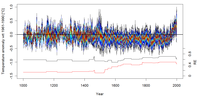In the first study of its kind in Australasia, scientists used 27 natural climate records to create the first large-scale temperature reconstruction for the region over the past 1,000 years.
Update: The research paper is withdrawn from publication following the identification of errors. American Meteorological Society is currently reviewing the data and results. For more details, please visit wattsupwiththat.com/2012/06/08 … w-finds-fatal-flaws/
The study led by researchers at the University of Melbourne, used a range of natural indicators including tree rings, corals and ice cores to study Australasian temperatures over the past millennium. They then compared these with climate model simulations.
Dr. Stephen Phipps, a researcher with UNSW’s Climate Change Research Centre and the Centre of Excellence for Climate System Science led the climate model simulation research. He said the results showed there were no other warm periods in the past 1,000 years that match the warming experienced in Australasia since 1950.
“Our study revealed that recent warming in a 1,000-year context is highly unusual and cannot be explained by natural factors alone, suggesting a strong influence of human-caused climate change in the Australasian region,” Dr. Phipps said.
The study published in the Journal of Climate will form the Australasian region’s contribution to the 5th IPCC climate change assessment report chapter on past climate.
Lead researcher, Dr. Joelle Gergis from the University of Melbourne said using ‘palaeoclimate’ or natural records, such as tree rings, corals and ice cores, are fundamental in evaluating regional and global climate variability over centuries before direct temperature records started in 1910.
Dr. Gergis collated these natural records provided by decades of work by more than 30 researchers from Australia, New Zealand and around the world.
The reconstruction was developed using 27 natural climate records calculated in 3,000 different ways to ensure that the results were robust.
She said reconstructions of regional temperature not only provide a climate picture of the past but also a significant platform to reduce uncertainties associated with future climate variability.
The study is part of a global collaboration, PAGES, Past Global Changes Regional 2K initiative, which is working to reconstruct the past 2,000 years of climate across every region in the world in order to reduce uncertainties associated with future climate change projections.
Collaborators include the Climate Change Research Centre and the ARC Centre of Excellence for Climate System Science, University of New South Wales where the climate modelling was conducted.
Journal information: Journal of Climate
Provided by University of New South Wales


.jpg)

















